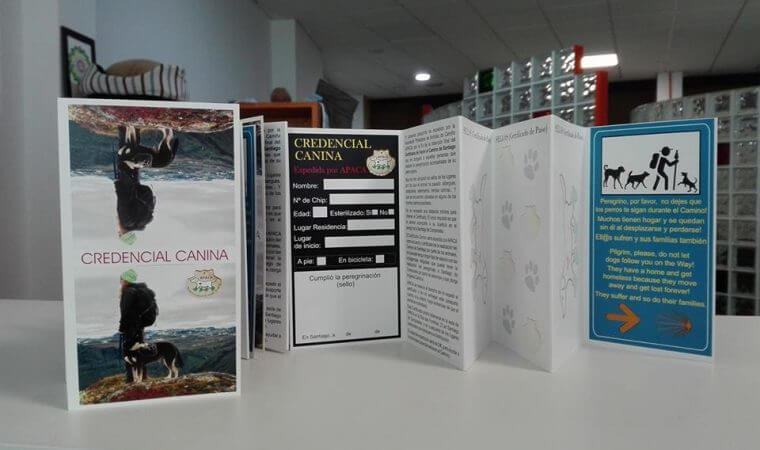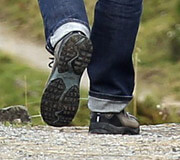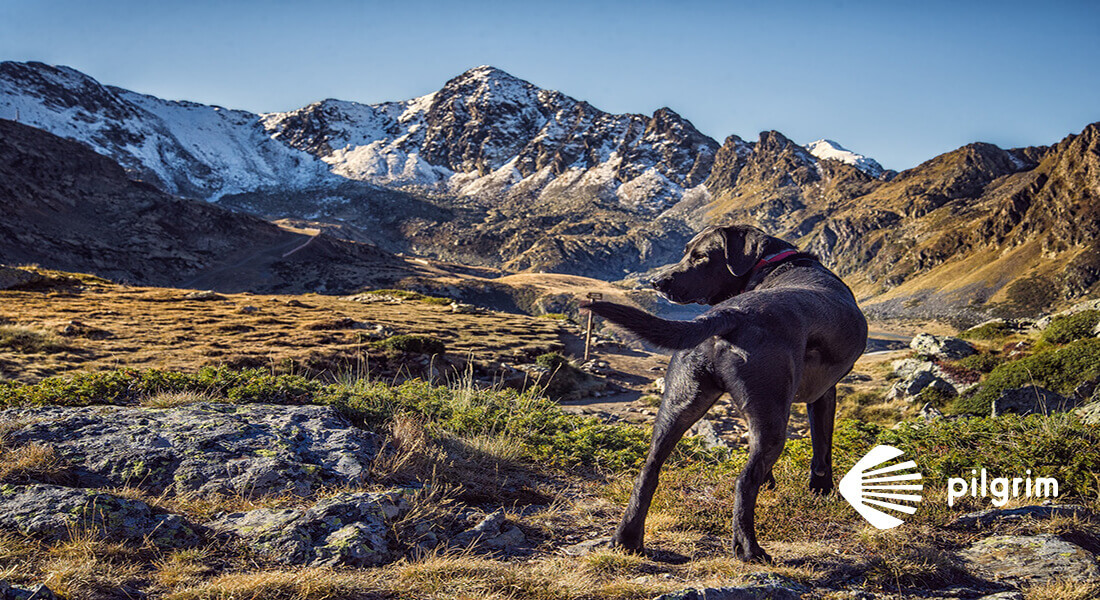Doing the Way of St. James with a dog will be an enriching experience that will make you grow both morally and spiritually, and will elevate your relationship to a higher degree, no matter how strong it may already be.
Next, we want to give you a series of tips and information in order to lose your fear and venture on the Camino de Santiago with your dog.
It is very important, if you walk with your dog, to avoid the inconvenience of not finding accommodation during your Camino.
You may also be interested in: What do I bring in my backpack to do the Camino?
Don’t worry, at Pilgrim we have a network of reliable accommodation where we know that animals are allowed.
Contact us and don’t worry about this great inconvenience that may become key during your pilgrimage.
On the contrary, if you want to know everything about how to do the Way with your dog, keep reading.
First, we want to talk to you about the harshness of doing the Camino de Santiago and more with your pet. It is not a question of discouraging you, just warning you, because although we will find infinity of positive things in doing the Way with our best friend, we will also live unfavorable situations that we will have to learn to manage, forming a team with our faithful companion.
Before starting the Camino de Santiago
Before we start walking we must know certain things regarding preparation, how to get to Sarria, etc.
Physical training
You will need a good physical preparation but our hairy friend also needs a good preparation. Although there are still people who believe that the animal does not suffer, gets tired, has shoelaces, etc.. We know for a fact that the Camino will be as hard for them as it is for us.
A couple of months before starting the Camino de Santiago, we recommend taking the dog for long walks to get him used to doing exercise.
Example of preparation
- Leave early in the morning to walk at a fast pace for an hour or so, in which we will travel about 7 km.
- Again, late in the afternoon, do 2 more hours, at a good pace. During this time, you can travel about 15 kilometers. In this way, at the end of the day, the dog will have done more than 20 kilometers.
- You will have to go through dirt, stone or road tracks in order to harden your pads as much as possible. However, there are also products that we can apply to your legs to help them harden and avoid injuries and bruises.
- Worm the animal inside and out; inside with an anti-parasite tablet and outside with an anti-flea pipette and ticks,
- Wear a water resistant tick collar during the stages. We will cross wooded areas where these harmful beings abound for our animal. In addition, we may meet other dogs along the Way and they are tick owners.
Backpack preparation
Previously, in another post, we talked about what to carry in the backpack during the Camino de Santiago, however, now we have the factor of carrying in it what is necessary for our pet.
What we still don’t know is what we need to bring to make the experience more enjoyable for our four-legged friend.
General object list
- Documentation of the animal:
- Veterinary health certificate and document accrediting anti-rabies vaccination.
- Certificate of identification with microchip and vaccination card
- Harness and leash: We recommend this accessory because the collar can end up damaging our dog if he has to be tied for a long time. Another good alternative is to get a canicross (a contraption to carry our pet tied to the hip).
- Dog raincoat.
- Quick drying towel: It is recommended to bring a specific towel for the animal.
- Foldable drinker: Made of waterproof fabric, very useful for its reduced size and weight.
- Food: We recommend carrying about two kilos of feed (preferably top-of-the-range) distributed in sachets of ration.
- Feeder: To mix feed with other foods.
- Stool bags: We must think that we will not only cross mountains and rural areas, but we will also walk along urban centers and above all we must be responsible with the acts of our pets.
- Dog footwear: To protect our dog’s pads.
- Cream for pads.
- Mat: In case our pet has to spend some night in the open air.
Dog Credential
Since the beginning of 2018, dogs that make the pilgrimage to Santiago de Compostela, can get, like its owner, the Perregrina or Compostela Dog.
This initiative is carried out by the Asociación Protectora de Animais do Camiño (APACA) in order to satisfy the multitudes of requests from pilgrims who make the Way of St. James accompanied by their pets and thus, raise awareness to hostels that facilitate access to their pets.
Although the credential does not have an official character because it does not have the seal of the Catholic Church, it is a great step to sensitize pilgrims to the abandonment of animals and their mistreatment on the Jacobean routes.
Its operation is the same as the conventional Pilgrim’s Credential, it must be stamped during the route and finally in Santiago, deliver the document in R/ Fontiñas 27, at the entrance of the city by the French Way.
How much does it cost and where to get it?
The price of the Dog Credential and the Perregrina is 3 €.
If you buy the pack, Credential + Compostela Dog, is 5 €.
In Galicia:
- In the APACA store, in Santiago de Compostela, (Rúa Fontiñas 27) Every Way.
- Ecoespazo Vitriol, in Sarria. Camino Francés
- San Lázaro Hostel in Sarria. Camino Francés
- Lucana Shop, in A Coruña. Camino Inglés
- Le Crepe da Pía. Porta da pía nº8, in Tuy. Camino Portugués
- Michocán, in Vigo. Camino Portugués
- Hostel Ponte Ferreira, in Lugar O Carballal, 2, 27206 Ferreira, Lugo
In Asturias:
- Castro Youth Hostel, in Grandas de Salime. Primitive Way.
- La Payariega Hostel, in La Carda, Villaviciosa. Northern Way
In Extremadura (Silver Route):
- Animal shelter of Plasencia, in Plasencia, Cáceres.
Travel Agencies (all Routes):
- Pilgrim: We will be able to give you the Dog Credential if you wish. Don’t be afraid to ask us.
Plan your adventure!
We can fill you in, no strings attached!
Best route of the Camino de Santiago to do with dog
You may have doubts about which route of the Way choose to make accompanied by your faithful friend.
It could be done in most of the routes, but we recommend Sarria, for its better accessibility for your pet and, above all, because we know that there are accommodations that allow the passage of animals.
We would not recommend another if we are not sure that your dog sleeps in a comfortable place.
How to get to Sarria with a pet to do the Way of St. James
Although we already know how to get to Sarria to do the Camino de Santiago, we are going to show you the differences that can arise when you go accompanied by your pet.
By train
- Cercanías: It is the only means of public transport in which you can travel with your dog regardless of its size. The only existing conditions are that it is tied up and if it weighs more than 10 kilos that it takes muzzle, another positive point of this means of transport is that your pet travels for free.
- Medium/long distance, AVE, etc.: Only dogs weighing less than 10 kilos may travel on one of these trains, always within a carrier of dimensions 60x35x35 cm, which we must carry. In addition, in most trains, we must pay a supplement to take our pet.
On the Renfe website we will find all the necessary information about the conditions that travelling with a pet is going to entail for us.
By bus
With the exception of the guide dogs, the law establishes that the animals will have to travel in warehouse inside a carrier, this solution does not seem to us very suitable because our dog will travel between suitcases and next to the noisy motor of the bus.
Imagine putting yourself in their situation, not going in a seat with all the comforts, and also receiving blows from the luggage of other passengers and with a shocking noise throughout the journey.
By plane
In low cost companies traveling with a dog is usually forbidden in any way.
In the rest of the company the “mini” dogs can travel in the cabin within a carrier (maximum 8 kilos and with prior authorization) and the rest of the dogs can travel in the hold, charging a supplement of the ticket.
The conditions in which dogs travel in the hold are not as bad as they used to be, since these compartments are separated from the rest of the luggage and are correctly acclimatized, without noise or other traumatic effects for pets.
By car
Undoubtedly, the most comfortable solution in terms of organization is to use our private car to get to the beginning of our Camino.
If we do not have this option, we can always rent a vehicle or hire a trip through Uber, some of the drivers offer the possibility of traveling with pets, so it may be the most recommended alternative if we do not manage our trip by public transport.
Accommodations between Sarria and Santiago that admit pets
It is very important to plan well the places where we are going to spend the night, since not everyone admits our four-legged companions.
List of accommodations
- Sarria: At the beginning of the Camino we have these accommodations available:
- Portomarín: At the end of the first stage we could sleep at the hostel El Caminante.
- Palas de Rei: After the second stage we could enjoy a nice night at guesthouse Maite.
- Arzúa: Pilgrims’ hostel Milky Way.
- O Pedrouzo: Relax at the guesthouse Codesal.
- Santiago de Compostela: After finishing the Camino we are sure that they will need to rest more than ever, and we believe that the Hotel A Tafona do Peregrino is the best option
It is an orientation that is open to availability of accommodation and modification of prices by seasons, if you want help booking accommodation do not hesitate to contact us through our email info@pilgrim.es
During the Camino…
Once on the road, if our pet is well prepared physically and equipment level, we are sure that he will wake up every day happy to continue the adventure with its owner, but we must take into account certain elements to avoid setbacks.
Loose or on a leash?
Surely, this doubt assails us in many moments along our walk, we cannot generalize in this subject since each situation and each animal requires of a different behavior.
It is not recommended either one end or the other, we should not tie or let our pet loose all the time.
Along the Camino de Santiago, we will find areas in which we can let our dog run free without any danger, while in certain sections in which we will travel along the shoulders of roads, we must tie it in short and control it.
Another issue to take into account is the process of adaptation to the distances of the stages, we must prevent it from exhausting its energies too quickly at each stage.
The first few days we must tie him more assiduouslybecause the animal can start running without control and get tired too soon, we must bear in mind that he does not know how much distance we are going to travel, with the passage of days, we will realize that he himself will dose his energies.
Food
The best thing is to try to change the diet of our animals as little as possible. We must increase the daily ration of food, since the effort that our dog is going to make will be greater than any made in the day to day.
It is possible that throughout the stage, our pet does not want to eat anything, a good solution is to have some kind of food reinforcement (energy, muscle protector, joint protector, etc.) and provide it at the time we stop to eat.
At the end of the stage, we will give you your daily ration of food, we recommend mixing the feed with a can for dogs, pâté or any specific food that involves a greater energy intake.
We must know that there are nutritional supplements containing vitamins, L-carnitine, electrolytes, … Before using them, we must consult with our veterinarian to know which is the most recommended for our case.
Hydration
It is essential to have enough water, it is not something we should leave to chance and trust the animal to drink where it can.
It is important to carry your own bottle to fill the drinking trough. Also, in this way, we can control how much you drink, give little by little the water not to waste it but without skimping, because he needs to hydrate as much or more than you.
Refreshing our dog, and constantly hydrating it, is a more than effective way to prevent heat stroke.
Care of the pads
It is essential to keep our dogs’ pads hydrated. Every night, before going to sleep, we must apply specific creams to hydrate them, in this way they will sleep while the ointment takes effect and in the morning they will be ready for a new stage.
If you choose to buy animal footwear, it is important that you wear it whenever you cross paved sections (asphalt, concrete, etc.).
This type of tracing can seriously damage the pads of our dog, in the case of covering long distances we must put the boots to do the last kilometers, simply for prevention, because as a result of the accumulation of distance traveled, the pads soften and irritate becoming weaker in front of cuts.
We must check every day the legs of our pet for scratches as a cause of the chosen footwear. Above all, look at the fifth finger, as this is usually the most affected by the use of canine boots.
In the event that this is affected, we must stop using these accessories during the days it takes to recover.
At the end of the Way…
Once you have passed all the stages, go to the APACA office to get the Dog Compostela or Perregrina so deserved for your faithful companion throughout the trip.
We are sure that neither you nor your pet will be the same, this experience will have changed you for life, and will have served to make your relationship even closer if possible.
After reading all the advice we give you here, on how to do the Camino de Santiago with Dog, we are sure that your desire to overcome the Camino will have multiplied, as this experience welcomes pilgrims with two legs and four legs alike. If you feel the urge to go on pilgrimage, don’t repress it. Do it!
Ultreia Pilgrims!


